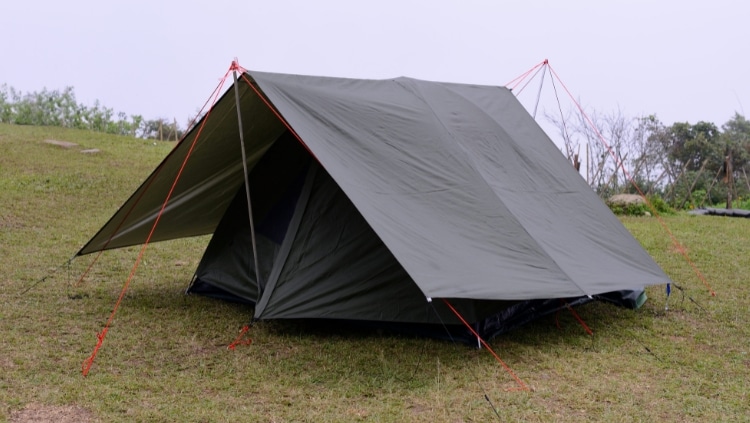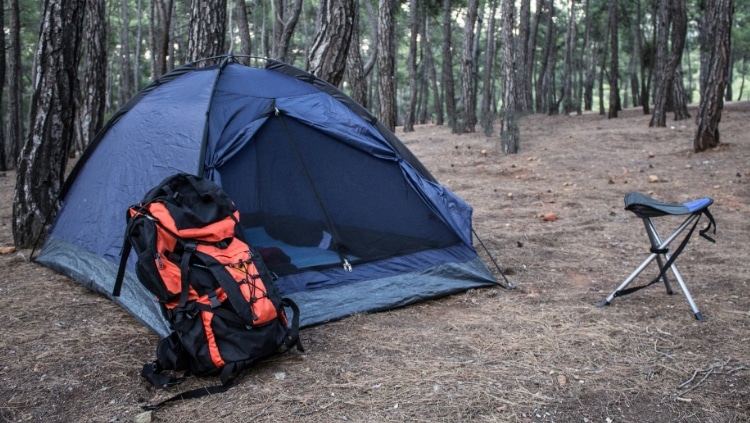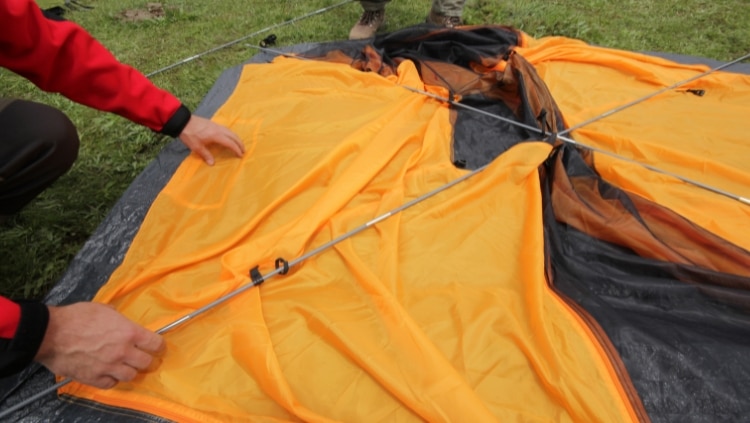If you’re in the market for a new tent, you may be wondering which tent material is best. During your search, you will likely come across three types of camping tent materials: canvas, nylon, and polyester.
Nearly every camping tent in the world is made of one of these materials, but it’s hard to know which one is best for you.
Which tent material is best depends on the type of camping you do. Nylon is best suited for backpacking. Polyester is mainly used for car camping, though some can be used for backpacking. Canvas can’t be used as a backpacking tent but is excellent for car camping, glamping, and packing with stock.
Let’s take a detailed look at these tent materials, their tradeoffs, and what makes the most sense for you.
Which Tent Material Is Best?
Which camping tent material is best depends on the intended use. Each material has pros and cons. Weight, durability, and comfort are all varying issues depending on the type of camping you plan to do.
The table below describes some of the main factors you should consider when it comes to tent materials, along with which material excels at what.
| Canvas | Nylon | Polyester | |
| Inexpensive | X | ||
| Durable | X | X | |
| Lightweight | X | ||
| Sustainable | X | ||
| Comfortable | X | ||
| Good for car camping | X | X | X |
| Good for backpacking | X | ||
| Good for glamping | X |
A good backpacking tent is much different than a good all-weather car camping tent. It depends on how weather-resistant, durable, lightweight, or inexpensive a tent you are looking for.
But if you’re packing into the backcountry on horseback or with pack animals like mules, llamas, or goats, you may be prone to cooking on cast iron and living it up in a big, comfy, canvas tent.
Here are a few key variables and why the distinctions are important.
Carrying Weight
Are you planning on hiking to your campsite? The weight of your tent is one of three things that many find most essential to cut down on (the other two being the weight of your cooking system and your backpack). Many backpackers strive to go ultralight with their gear for an easier, more comfortable hiking experience.
Backpacking tents need to be lightweight and easily packable. This is why nylon tents are the best option for backpackers. Some nylon tents can boast carrying weights of two pounds or less.
Of course, lightweight gear may not interest you at all. If you’re not hauling a tent up a mountain or through the woods, carry-weight can be taken out of the picture. Canvas would be the best option for someone who doesn’t care about a bulky tent as long as it is heavy-duty, durable, and comfortable.
Sustainability
If you’re anything like me, sustainability is an essential factor when choosing outdoor gear.
Unsurprisingly, synthetic material such as nylon and polyester is less sustainable than natural fibers such as canvas.
All synthetic, man-made fibers are actually a form of plastic. They are a cause of emissions the same way any product created from fossil fuel is. They will never fully biodegrade and will be on the planet forever.
Canvas is a natural material. It is a weave made out of thick cotton fibers. Because it’s made out of cotton, it is biodegradable. A canvas tent, if thrown away, will eventually break down rather than eternally sit in the landfill.
Canvas isn’t a perfect ten on the eco-friendly scale. There are a lot of environmental issues with the cotton industry. Cotton is responsible for an unsustainable level of water usage across the world. Water diverted to cotton farms has drained lakes and decimated watersheds. It also is responsible for pesticides leaking into the surrounding land.
However, any natural material is inherently more sustainable than material made from petroleum. It does not create the same level of emissions, nor is it a “forever” product. Canvas is the most sustainable material for tents currently available.
Durability
Nylon and canvas are both very durable materials. They are different in how they are made, but both hold up very well.
Canvas is a step above because it is a heavier material with thicker threads. It is easier to repair if necessary with just a needle and thread. Synthetic tent materials require a special patch kit to repair them if they rip.
Polyester does not hold up as well as nylon. Some brands have developed ripstop poly blends in an attempt to increase the strength-to-weight ratio and durability of polyester tents. These will be more expensive than regular polyester.
Despite its durability, canvas is much more susceptible to rot if it is not taken care of properly. If you pack your canvas tent away wet, it will decay. This is, however, a relatively unimpactful issue as long as you care for your canvas tent. Let it dry out before storage and the problem is negligible.
Comfort
Canvas regulates the temperature inside your tent and makes for a more comfortable experience. They hold in heat very well in colder temperatures and provide cool shade in warmer temperatures.
Nylon and polyester don’t hold in heat the same way. They also generally require a separate rain fly if you want shade when it is warmer outside. A canvas tent will be warmer in the cold and cooler in the heat than synthetic tent materials.
Canvas vs. Nylon

Both canvas and nylon are widely used, yet very different, tent materials. It’s a bit like comparing apples to oranges.
Both of these tent materials are high-quality and durable. Their design, and mostly their weight, are what sets them so far apart.
Nylon tents are lightweight and packed down to be quite compact. Their tent poles are thin, light, and simple. Pitching a nylon tent is quick and easy. They make wonderful backpacking tents. When simplicity, size, and weight are the issue, nylon tents stand out.
Canvas is bulky and heavy. It can’t be packed down small enough to be a backpacking tent. You also wouldn’t want to carry it hiking, as its weight is so significant.
Canvas makes a wonderful heavy-duty tent for comfortable car camping, glamping or long-term tent stays.
Because it is a hefty material, a canvas tent is better equipped than nylon to handle all sorts of weather. 4-season synthetic tents do exist, but they are costly. Canvas will stand up to the elements better than most nylon tents. This makes it an excellent option for winter camping.
Which Material is Better, Canvas or Nylon?
Whether you should choose a canvas or nylon tent depends entirely on your intended use. Nylon is better for a backpacker. Canvas is better for a car camper or glamper. The big difference is in their design and vast polarity in carry-weight.
They are both great options for their specific uses. Nylon will be a high-quality lightweight tent. Canvas is great for a comfortable, long-lasting, heavy-duty tent.
Canvas vs. Polyester

Canvas and polyester are both tent materials used for car camping and developed campgrounds. Neither is recommended for backpacking or trekking. Both are too bulky and heavy.
The biggest difference between the two is that canvas is a heavy-duty car camping material that will hold very well to the elements. Polyester is cheaper, more lightweight (though not as light as nylon), uses a separate rain fly, will not regulate temperature, and is not very durable.
Many car camping tents are made of polyester. They are very widely available. These will look similar to the design of nylon tents with a large mesh panel, a separate rain fly, and a lightweight pole structure.
Polyester tents will be significantly more lightweight than canvas, though it is not an ultralight material like nylon can be. Many polyester tent options will be easier to haul around and less bulky to set up and pack away than canvas. Think of a six to ten-pound tent (polyester) versus a thirty-pound tent (canvas).
However, polyester’s strength-to-weight ratio is very poor compared to canvas. Canvas, being a durable material with thick natural fibers, will hold up better in the long run than a polyester tent.
Like nylon, polyester as a synthetic option will not weather in the sun and other elements as well as canvas. UV rays will slowly deteriorate them. Canvas does better against this and doesn’t break down in the sun the same way.
The all-weather durability of canvas also contributes to a huge comfort factor that polyester can’t match. Canvas tents can withstand bitter cold and beating sun while still holding up. Because of the way it regulates temperature, holds in heat, and stands up to the elements, canvas is the way to go if you’re planning on camping in the winter.
Canvas is the best option for glamping. Smaller canvas car camping tents are also available, similar in size to many polyester tents you may find. Canvas tents come in many different designs. You will have the option of car camping in luxury or in a small one or two-person canvas tent.
A polyester tent is fine for many people’s car camping usage. A canvas tent would be a level up in comfort that would likely be worth it for many reasons if you’re willing to increase your price point.
Polyester vs. Nylon

Polyester and nylon are both synthetic fabrics, but they are quite different in their performance, weight, and cost.
These two types of materials may be the most confusing to compare. Many nylon and polyester tent designs may look nearly identical. The difference is in their specs and durability.
You may see a $500 nylon tent and a $300 polyester tent with an extremely similar design. Nylon tents will usually be towards the top of the price spectrum. Polyester tents are a good budget option. However, there is a reason that they are cheaper.
Polyester tents tear more easily than nylon and generally have a poor strength-to-weight ratio. They are not as durable of a material and tend to be heavier. The weight difference may only be a few pounds, but those pounds add up on a hike especially when the heavier tent won’t hold up as well.
If you are car camping and trying to decide between nylon and polyester tent materials, consider the investment you’d like to put into your tent purchase.
A nylon tent will work great for car camping and can also be taken on backpacking trips. A polyester tent will do you just fine for car camping, but you will eventually need to upgrade if you intend to hike to camp.
When to Use Which Type of Tent

Ultimately, when to use each type of tent really comes down to what kind of camping you’re doing. Additionally, think about whether you are in a position to sacrifice carry weight for durability, longevity, and extra comfort.
Backpacking
As a backpacker, I exclusively use nylon tents. None of the benefits of canvas are worth the weight and the lack of packability for the type of camping I do. Using canvas for this type of camping is not realistic or doable. Polyester’s poor strength-to-weight ratio also doesn’t fit my criteria.
My nylon tent weighs just a few pounds. It stuffs down into a sack or around the gaps in my backpack and becomes extremely compact. A canvas or polyester tent is not capable of that.
Any ultralight backpacking tent you will find will be made out of nylon. I would not recommend any other type of tent material to a backpacker.
Car Camping
If you’re not trekking to get to your campsite, a canvas tent’s comfort and durability is worth it. They are great for car camping and developed campgrounds. Canvas has better strength and weather resistance than both nylon and polyester.
While synthetic tents can definitely be used for car camping, canvas is a step above them. It will be a significant upgrade in comfort for your camping experience.
Glamping and Long-term Camping
Looking to do “glamping” or long-term living in a tent? Canvas is the option for you here. When I was living in a tent for extended periods, including in winter months, it was a canvas tent. It was large enough for a small bed, a wood stove or heater, and other furniture.
The canvas material kept the heat in even during some freezing nights. It kept me warm and dry during some snow. It also provided shade during the height of the summer.
For good reason, bell tents, yurts, and tent cabins are all usually made of canvas. Canvas is the way to go if you’re setting yourself up for the long haul in a tent.
Winter Camping
While you can find 4-season synthetic tents, canvas really shines for winter camping as well. Canvas holds in heat (without condensation) in a way that synthetic tents do not. A bit of snow doesn’t phase a canvas tent, either.
If you’re planning on spending a good chunk of your camping time in the winter, adding a canvas tent to your lineup would be a smart investment.





